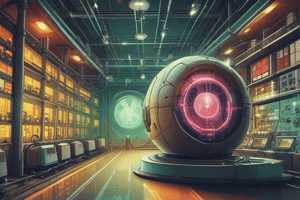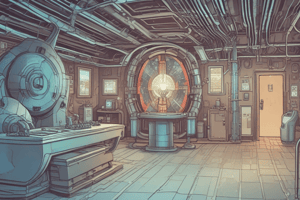Podcast
Questions and Answers
What is the total number of known radionuclides?
What is the total number of known radionuclides?
- 2000
- 3000
- 4000
- 2700 (correct)
How are radionuclides used in medical imaging produced?
How are radionuclides used in medical imaging produced?
- Through chemical reactions
- Naturally
- Artificially (correct)
- Both naturally and artificially
What occurs when an additional neutron is forced into a stable nucleus?
What occurs when an additional neutron is forced into a stable nucleus?
- A proton deficit
- An atomic number change
- A neutron excess (correct)
- A neutron deficit
What is the result of adding a neutron to the nucleus of Molybdenum-98?
What is the result of adding a neutron to the nucleus of Molybdenum-98?
What type of particle is accelerated in a cyclotron?
What type of particle is accelerated in a cyclotron?
What is the result of adding a proton to the nucleus of Oxygen-18?
What is the result of adding a proton to the nucleus of Oxygen-18?
What is the typical half-life range of radionuclides produced in a cyclotron?
What is the typical half-life range of radionuclides produced in a cyclotron?
What is the purpose of medical minicyclotrons?
What is the purpose of medical minicyclotrons?
What is the half-life of 99mTc?
What is the half-life of 99mTc?
What is the result of the decay of 99mTc?
What is the result of the decay of 99mTc?
Which type of decay is characterized by a neutron deficit?
Which type of decay is characterized by a neutron deficit?
What is a positron?
What is a positron?
What is the result of β+ decay in Fluorine-18?
What is the result of β+ decay in Fluorine-18?
What is the process by which a nucleus captures an extranuclear electron?
What is the process by which a nucleus captures an extranuclear electron?
What is emitted when an electron from an outer shell fills a vacancy in the K-shell?
What is emitted when an electron from an outer shell fills a vacancy in the K-shell?
What is the result of K-electron capture?
What is the result of K-electron capture?
What is the half-life of the parent in a technetium generator?
What is the half-life of the parent in a technetium generator?
What is the purpose of elution in a technetium generator?
What is the purpose of elution in a technetium generator?
How often can elution be made from a technetium generator?
How often can elution be made from a technetium generator?
What happens to the molybdenum after elution?
What happens to the molybdenum after elution?
What is the half-life of technetium-99m?
What is the half-life of technetium-99m?
What is the purpose of using sodium pertechnetate-99mTc?
What is the purpose of using sodium pertechnetate-99mTc?
What is the purpose of administering potassium perchlorate in thyroid imaging?
What is the purpose of administering potassium perchlorate in thyroid imaging?
How often is a technetium generator usually replaced?
How often is a technetium generator usually replaced?
What happens to the activity of technetium-99m after 24 hours?
What happens to the activity of technetium-99m after 24 hours?
What is the use of methylene diphosphonate (MDP) labelled with technetium-99m?
What is the use of methylene diphosphonate (MDP) labelled with technetium-99m?
What is the use of hexamethyl propylene amine oxime (HMPAO) labelled with technetium-99m?
What is the use of hexamethyl propylene amine oxime (HMPAO) labelled with technetium-99m?
What is the use of diethylene triamine pentacetic acid (DTPA) aerosol labelled with technetium-99m?
What is the use of diethylene triamine pentacetic acid (DTPA) aerosol labelled with technetium-99m?
What is the use of autologous red cells labelled with technetium-99m?
What is the use of autologous red cells labelled with technetium-99m?
What is the use of heat-damaged autologous red cells labelled with technetium-99m?
What is the use of heat-damaged autologous red cells labelled with technetium-99m?
What is the characteristic of 131I that makes it an excellent label?
What is the characteristic of 131I that makes it an excellent label?
What is the primary radiation emitted by 131I?
What is the primary radiation emitted by 131I?
Which radionuclide is used for thyroid ablation?
Which radionuclide is used for thyroid ablation?
What is the half-life of 123I?
What is the half-life of 123I?
Which radionuclide is used for brachytherapy seeds?
Which radionuclide is used for brachytherapy seeds?
What type of radiation does 133Xe emit?
What type of radiation does 133Xe emit?
How is 81mKr produced?
How is 81mKr produced?
What is the half-life of 81mKr?
What is the half-life of 81mKr?
What is the parent radionuclide of 81mKr?
What is the parent radionuclide of 81mKr?
What is the energy of the gamma rays emitted by 133Xe?
What is the energy of the gamma rays emitted by 133Xe?
How is the patient administered 81mKr for pulmonary ventilation studies?
How is the patient administered 81mKr for pulmonary ventilation studies?
What is the advantage of 123I over 125I?
What is the advantage of 123I over 125I?
Flashcards are hidden until you start studying
Study Notes
Production of Radionuclides
- There are over 2700 known radionuclides, but only some are used in medical imaging.
- Radionuclides are produced artificially in two ways:
- Neutron excess: adding a neutron to a stable nucleus, resulting in a neutron excess (e.g., 98Mo + n → 99Mo).
- Neutron deficit: adding a proton to a stable nucleus, resulting in a neutron deficit (e.g., 18O + p → 18F + n).
Radionuclides with a Neutron Excess
- Radionuclides with a neutron excess undergo β- decay.
- Example: 99mTc (half-life = 6 hours) decays to 99Tc (unstable, half-life = 211,000 years), which decays to ruthenium-99 (stable).
Radionuclides with a Neutron Deficit
- Radionuclides with a neutron deficit undergo β+ decay or K-electron capture.
- Example: 18F (fluorine-18) with atomic number 9 transforms into 18O (oxygen-18) with atomic number 8, resulting in a decrease in atomic number but no change in mass number.
Technetium Generator
- A technetium generator is used to produce technetium-99m (99mTc).
- 99mTc is washed off the column (eluted) with sterile saline solution, leaving behind the molybdenum (99Mo).
- Elution takes a few minutes and can be repeated daily.
Uses of Technetium-99m
- Sodium pertechnetate-99mTc is used for imaging tissues, such as:
- Thyroid, gastric mucosa, and salivary glands
- Cerebral blood flow and testicular imaging (with potassium perchlorate)
- Gastric emptying studies (with bran porridge)
- 99mTc can be labeled to various compounds for:
- Bone imaging (methylene diphosphonate, MDP)
- Cerebral imaging (hexamethyl propylene amine oxime, HMPAO)
- Renal studies (dimercaptosuccinic acid, DMSA, and mercaptoacetyltriglycine, MAG3)
- Biliary studies (iminodiacetic acid, HIDA)
- Liver, spleen, and red bone marrow imaging (human serum albumin, HSA)
- Lung ventilation studies (diethylene triamine pentacetic acid, DTPA, aerosol)
- Cardiac function and perfusion imaging (autologous red cells, sestamibi, or tetrofosmin)
Other Radionuclides and Their Uses
- Iodine-131 (131I): used for thyroid imaging and therapy, but largely replaced by 123I due to its long half-life and beta emissions.
- Iodine-123 (123I): used for thyroid imaging, more expensive than 131I, but with a shorter half-life and fewer beta emissions.
- Iodine-125 (125I): used for therapy, particularly brachytherapy seeds.
- Xenon-133 (133Xe): used for lung ventilation imaging, produced in a nuclear reactor, and has a half-life of 5.2 days.
- Krypton-81m (81mKr): used for pulmonary ventilation studies, produced in a generator, and has a half-life of 13 seconds.
Studying That Suits You
Use AI to generate personalized quizzes and flashcards to suit your learning preferences.




